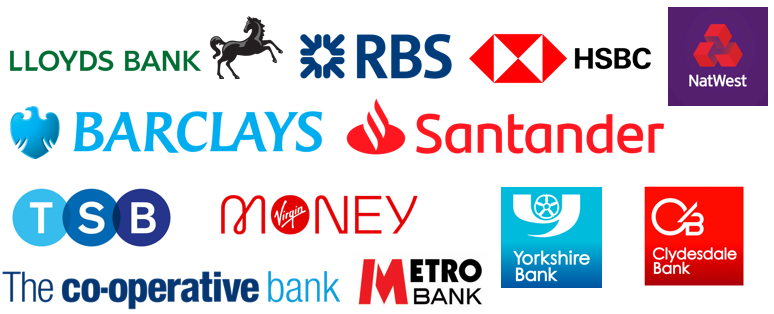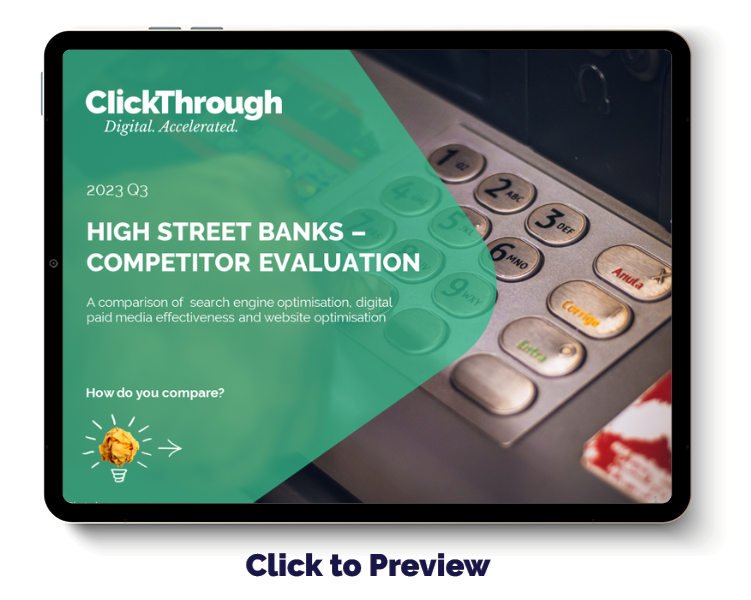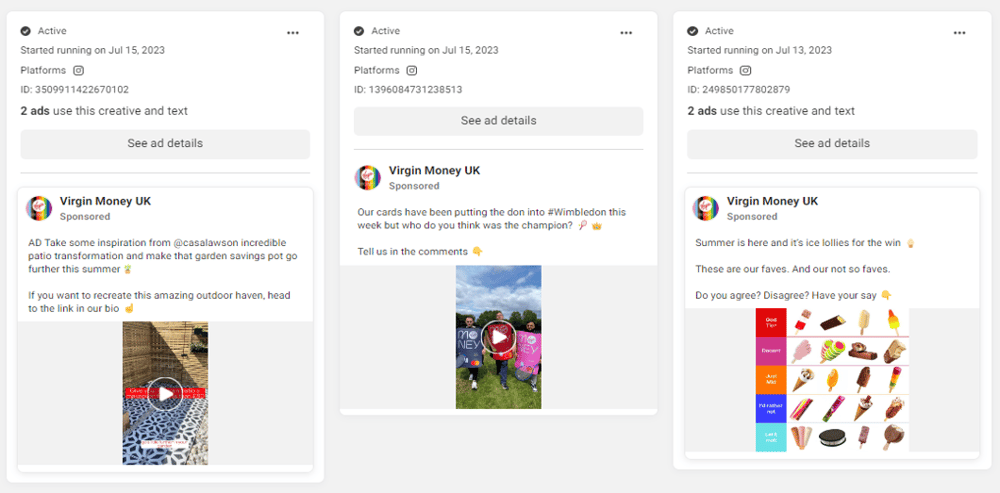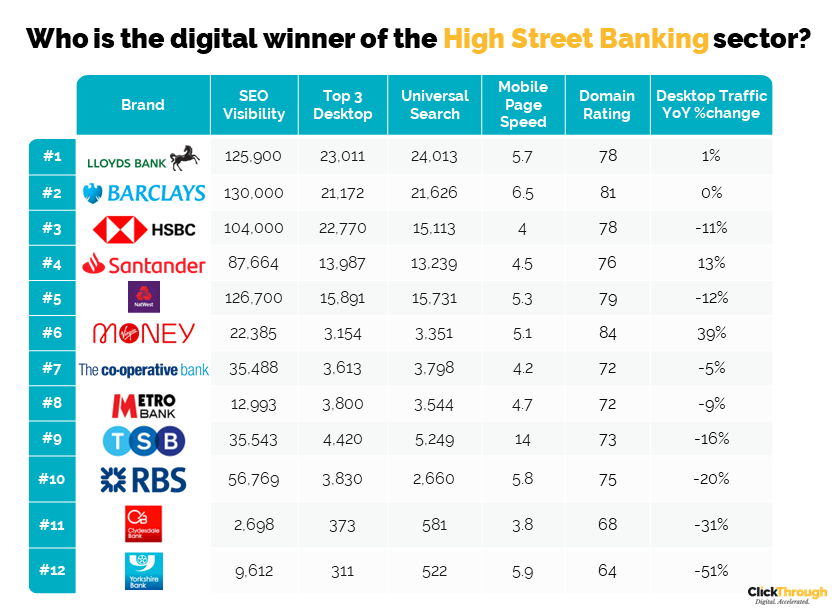The Q3 2023 benchmarking report for UK high-street banks has just been published. Learn how the top 12 UK high-street banks perform across the digital space.
The latest Q3 2023 benchmarking report for UK high-street banks has just been published. It covers the largest 12 national high-street banks, including Lloyds, NatWest, Barclays, Royal Bank of Scotland, HSBC, Metro, Santander, TSB, The Co-operative Bank, Virgin Money, Yorkshire Bank, and Clydesdale.

The research gives an inside track on who is winning the biggest share of voice online, and quantifies the gaps, risks and missed opportunities for other high-street banks to win brand exposure, drive online visits, and generate in-branch footfall. The report highlights quick wins that will improve enquiries from your online strategy and identifies the barriers that may be reducing your site’s ability to optimise digital performance.
To see a preview and contents page of the Q3 report, click here. To get a copy of the full report and the key takeaways, please complete the enquiry form or schedule a call.
What The Industry Research Report Covers
The 70+ pages of research benchmarks each retailer based on 50+ metrics and indicators of successful digital strategy, including organic visibility, domain authority, paid media ads, conversion performance, technical performance, site speed, universal search, content, social ads, accessibility, and mobile performance.
Driving Optimal ROAS from Paid Media Channels
Some of the leading players in the space are high spenders on paid media channels such as Google, Bing & Facebook - but have a poor or sub-optimal conversion improvement strategy. Without an optimised, sophisticated conversion strategy that maximises the conversion rate, the return on investment is unsustainable or will underperform. Scaling spend on paid media is not achievable unless the conversion rate delivers optimal performance in the sector. Some in the space have paid media spend levels from 30k+ per month but dedicate minimal resources and budgets to conversion testing. Given the cost per clicks on ad networks will continue to rise, we recommend spending at least 10% of your paid media budget on ongoing conversion optimisation testing schedules to ensure your paid media ROI maintains long-term viability, competitive advantage, and sustainability.
Technical Website Compliance
Savvy digital marketers know that having a technically sound website is an essential component of a successful fully integrated digital strategy - plus a site capable of maximising conversion performance. Bank customers need to trust their providers to give an excellent level of service and a site full of dead ends due to 4xx errors is likely to reduce consumer confidence.
UK high-street banks generally have few 4xx or 5xx errors, with most banks returning less than 100 in our crawls (though this should ideally be as low a figure as possible). In our last report, we noted that Virgin Money was flagging with the highest volume of 4xx errors, with 99. Virgin Money has since reduced this figure to 36 - a significant improvement. Santander now has the largest amount of 4xx errors, with a total of 296.
Site Speed & Conversion Rate Performance
When 62% of consumers are less likely to convert if they have a negative mobile site experience, ensuring that your site is quick and easy to load makes a significant improvement on your overall conversion rates. As with ensuring sites are technically compliant, banks can improve consumer confidence by providing a quick, seamless experience through mobile page speed.
In our last report, mobile page speed scores ranged from 13 to 65, with three banks scoring in the 'okay' range (as laid out by Google). In Q3, these scores ranged from 8 to 58, in line with universal falls in performance across all sectors we specialise in. We noted that TSB had seen a big fall in performance in our last report, however, TSB has since maintained its score, despite all other banks seeing dramatic drops.
Building Competitive Advantage with Domain Authority
Domain authority is an essential metric for measuring the effectiveness of SEO performance and helps create a reliable overall gauge of how effective your site is at achieving organic traffic, i.e. ‘free’ traffic that isn’t gained through sponsored ads. High-street banks can build their DA by sharing information about money-saving techniques, demographic studies of spending, and guides on different financial products.
A ‘good’ DA really comes down to how your competitors are performing however, it’s generally considered average between 40 and 50, good between 50 and 60, and excellent above 60. In our last report, DAs for high-street banks ranged from 66 to 84. There has been little movement since, with scores in Q3 ranging from 64 to 84. Though Yorkshire Bank are still the lowest-scoring high-street bank when it comes to DA, a score of 64 remains excellent and is a great indication of trust and authority.
Organic Performance – Mobile & Desktop
A strong organic performance is strategically important as it ensures your site ranks above competitors for key, transactional keywords. When 93% of your customers won’t go past the first page of Google, your absence or lack of targeting for essential keywords will cost you conversions. High-street banks may see increased traffic from account holders shopping around for better interest rates, or to find better deals on credit cards and loan options during the cost of living crisis.
Three of our high-street banks have seen an increase in organic traffic year on year. As in our last report, Virgin Money and Santander have both maintained an increase in organic traffic. However, Lloyds Bank has replaced The Co-operative Bank as the third bank to see any increase in visitors. The biggest loss in digital footfall in Q3 has been seen by Yorkshire Bank, which lost 49% of its traffic.
Universal Search Opportunity
Google Universal Search Results is an evolving opportunity to make your pages visible on a SERP (Search Engine Results Page). Universal results often appear before traditional listings and are eye-catching for users. Universal search results refer to rankings on a SERP that are not the traditional ‘blue line’ Google link, and a retailer can appear for universal search results without being strong in standard rankings. 'Local pack' could prove to be a beneficial Universal Search result for high-street banks to generate in-branch footfall, while 'people also ask' results provides an opportunity for banks to share information about key products.
'People also ask' remains the most-used Universal Search result. Whereas in our previous report, Barclays had secured the most appearances for these results, Lloyds has now taken the lead with 18,000. A strong performance for 'people also ask' results usually indicates a good approach to longtail keyword strategy, a chance to rank for high conversion-potential terms.
The Longtail Keyword Opportunity
Longtail keywords are often considered high intent and potentially more likely to convert as a searcher is being more specific. Optimising for longtail keywords also puts your content strategy in a strong position to rank for retailer new search terms as they enter Google’s index. Banks will want to ensure their longtail keyword strategy includes topical terms and questions that are likely to gain visitors, such as queries surrounding mortgage renewals,
While Lloyds Bank rank for fewer longtail keywords than Barclays overall, Lloyds has secured more appearances within the top three, ten, and twenty results. Though Barclays may have a much broader longtail keyword strategy, Lloyds' appearances for higher positions suggests better, more powerful content that is appealing for these high-conversion terms.
Facebook Adverts
With the number of Facebook users in the United Kingdom (UK) forecast to hit over 42 million users by 2022, it is not surprising that companies have jumped at the opportunity to advertise on the social media platform. Facebook’s UK digital advertising revenue has been estimated to have breached 2.6b GB pounds in 2019.
Below, we've included examples of Virgin Money's Facebook ads. Virgin have tapped into mobile-first browsing, using two verticle video ad formats that will blend into Meta's Reels content. They've also added 'AD' at the beginning of one set of copy. Though this isn't a requirement for Facebook ads (as they are clearly signposted as part of their setup), this does make the ad feel more native among influencer content.
Interestingly, Virgin Money has also used Facebook ads to boost an organic post which has absolutely nothing to do with the products they offer. However, by promoting a piece of engaging content, they are boosting visibility, improving brand awareness, and securing an audience for later posts.

Top Social Shares & Content
When it comes to social media and on-site content strategies, it is important to release content that has a longer shelf life. An article is considered 'Evergreen' if it has maintained its relevancy to an audience for longer. It's great for your retailer engagement, but great for Google too, who will recognise content which achieves traffic over a long period of time. As with improving DA and generating backlinks, high-street banks can create informative, engaging content that educates social media users about different financial products. However, as seen in Virgin's Facebook ads, social media is also an opportunity to have fun with their brand, and secure engagement from non-money focussed content.
Facebook is the platform of choice for almost all high-street banks. HSBC has, by far, won the largest audience on social media, with a total of 3.1 million Facebook likes. This represents a huge audience that are readily connected with the brand and more likely to see content as and when it is posted.
Website Readability & Accessibility
20% of people in the UK have a disability – 2 million of which are people living with sight loss. In addition, 1 in 12 men and 1 in 200 women have some degree of colour vision deficiency. When websites are not designed to meet these needs, retailers lose customer interest as they turn elsewhere. As banking is a universal need, high-street banks must ensure they're able to serve a site that is easy to navigate and trust in to anyone with a vision deficiency.
In our last report we noted that Yorkshire Bank had remained the site with the most accessibility barriers. While Yorkshire Bank has made no improvements, still returning 42 contrast errors and 103 alerts on their site, Clydesdale Bank is also now recording the same level of alerts. As Yorkshire Bank is part of Clydesdale Bank, it is unsurprising that the sites are facing similar challenges.
Q3 2023 WINNERS LEADERBOARD
For a glance into just 6 of the metrics, we evaluated these top 12 high-street banks on, check out our quick-look table below;

GET THE FULL 79-PAGE Q3 2023 REPORT
To get a copy of the full report, please complete the enquiry form. If you want to talk to us about accelerating your digital performance, please call us on 01543 410014 or schedule a call with Mike Movassaghi.
Photo by Humphrey Muleba on Unsplash





Let's be social
Join our growing social communities to learn more about the benefits of digital marketing and the people who make us tick.